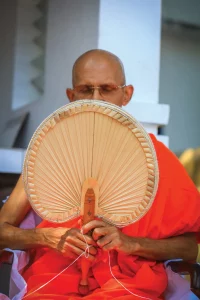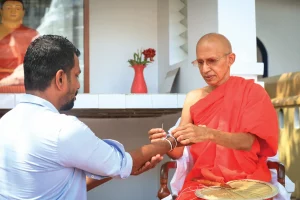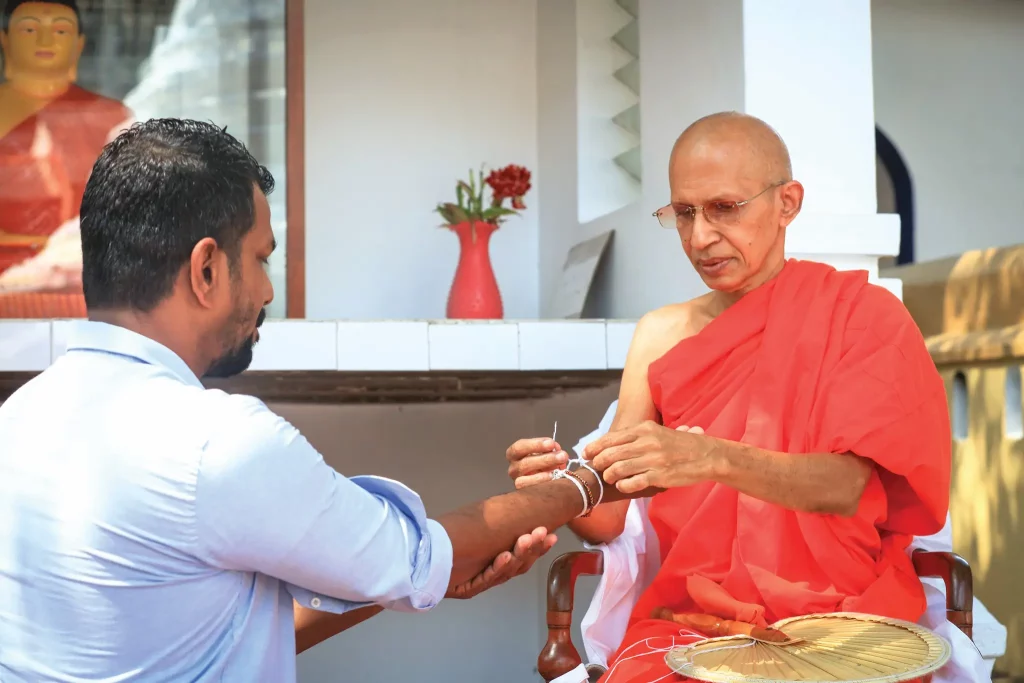
The recital of Pirith or Paritta is known as a form of blessing and protection. By listening to Pirith, inner peace and well-being are inculcated as it can be a form of meditation as well. Ven Diyapattugama Revatha Thero, Chief Incumbent of the Siriwardhanaramaya Temple, Colombo 3, explains the significance and benefits of Pirith. In today’s world where people experience stress, anxiety and depression, listening to Pirith will provide overall protection and peace.
Words Udeshi Amarasinghe. | Photography Menaka Aravinda.
The practice of recital and denotes loving and kindness and was listening to Pirith also known  as Paritta in Pali (meaning protection) began very early in the history of Buddhism. The definition of Pirith in Pali is “Pari Samanthatho Thãyathi Rakkathi Thi Pariththang Antharayang Parihanthang Thayathi, Thi Pariththang Paritho Wa Sambuddhawatho Thayathi Thi Pariththang”. This means that Pirith will provide protection from all forms of sadness, fear and illness, danger, and disasters including accidents. The first sermon by the Buddha was the Dhammachakka Pawaththana Sutraya, which narrates the Dhamma and the Chathurarya Sathya (Four Noble Truths). The Karaniyametta Sutraya taught by the Buddha to Buddhist Priests who had difficulty meditating as the Devivaru (deities) in the trees were creating scary forms. By reciting the Sutra, the Buddhist Priests were able to focus on love and kindness (Maithriya) to the deities who left them in peace thereafter. These are examples of the reciting of Sutra during the Buddha’s time.
as Paritta in Pali (meaning protection) began very early in the history of Buddhism. The definition of Pirith in Pali is “Pari Samanthatho Thãyathi Rakkathi Thi Pariththang Antharayang Parihanthang Thayathi, Thi Pariththang Paritho Wa Sambuddhawatho Thayathi Thi Pariththang”. This means that Pirith will provide protection from all forms of sadness, fear and illness, danger, and disasters including accidents. The first sermon by the Buddha was the Dhammachakka Pawaththana Sutraya, which narrates the Dhamma and the Chathurarya Sathya (Four Noble Truths). The Karaniyametta Sutraya taught by the Buddha to Buddhist Priests who had difficulty meditating as the Devivaru (deities) in the trees were creating scary forms. By reciting the Sutra, the Buddhist Priests were able to focus on love and kindness (Maithriya) to the deities who left them in peace thereafter. These are examples of the reciting of Sutra during the Buddha’s time.
The beginning of Pirith is believed to have been in Visala Maha Nuwara in India. There had been a pandemic in the city, and the Buddha had taught Ananda Maha Rahathanwahanse to recite the Rathana Sutraya throughout the city, thereby providing protection from the pandemic. In Sri Lanka, Pirith had become a more organized form during the Dambadeniya Period. Further, the Buddha during his visit to Sri Lanka in his ninth month after enlightenment had recited Pirith for the protection of the country. It is also believed that when Gautama Buddha was a Bodhisattva, he had recited the Mora Paritta.
Pirith is recited from the Pirith Potha (book) known as the Piruwana Poth Wahanse, which consists of Sutra that have been extracted from various sections of the Tripitaka. Buddhist Priests have to study and memorize all the Sutra for the recital of Pirith. Reference of this is made in the stone inscriptions in Abhayagiriya of King Kashyapa V states that a Samanera (novice) priest should study Pirith. The Pirith Potha consists of four sections known as Sathara Banawara. Each Banawara (section) has a number of Sutra, the first Banawara being the longest with 11 Sutra and five other sub-sections. Within Pirith, you have the Deshana (sermons) and Dhamma as certain Sutra focus on the Dhamma. For example, the Dasa Dhamma Sutra focuses on the Dhamma. Pirith is complex in its composition and has great value in meaning and spirituality.
Seth Pirith and Maha Piritha are the two forms of Pirith. Seth Pirith is mainly to infer blessings and can be recited in one session in the morning (around 6.30am) or as a Waru Piritha, where it is recited in three sessions within a day either at 6.30am or 6.30pm. Mangala Sutra, Rathana Sutra and the Karaniyametta Sutra together with a few other Gatha form the Seth Pirith. This Pirith is recited for special occasions such as birthdays, wed- dings, and laying of Foundation Stone and other such events.

 The Maha Piritha is recited by 12 Buddhist Priests throughout the night and is generally from 9.30pm to 5.30am. The Pirith ceremony has to conclude before sunrise. For the Maha Piritha the entire Sathara Banawara are chanted and the Buddhist Priests are allocated accordingly as the Pirith is recited all night. The Maha Piritha too is a form of blessing and protec- tion. It will dispel any evil or Butha Dosa. It is held in remembrance of those who have passed away, for birthdays, special occasions as moving into a new home or building, and it is also recited prior to state events such as Independence Day. It is said that Buddhist Priests should recite Pirith in the same manner as Ananda Maha Rahathunwahanse. Furthermore, prior to reciting of Pirith, an invitation is extended by the Buddhist priests to the devotees to listen and they too repeat the Gathawa after the priests.
The Maha Piritha is recited by 12 Buddhist Priests throughout the night and is generally from 9.30pm to 5.30am. The Pirith ceremony has to conclude before sunrise. For the Maha Piritha the entire Sathara Banawara are chanted and the Buddhist Priests are allocated accordingly as the Pirith is recited all night. The Maha Piritha too is a form of blessing and protec- tion. It will dispel any evil or Butha Dosa. It is held in remembrance of those who have passed away, for birthdays, special occasions as moving into a new home or building, and it is also recited prior to state events such as Independence Day. It is said that Buddhist Priests should recite Pirith in the same manner as Ananda Maha Rahathunwahanse. Furthermore, prior to reciting of Pirith, an invitation is extended by the Buddhist priests to the devotees to listen and they too repeat the Gathawa after the priests.
The Maha Piritha is recited within the Pirith Mandapaya (a special platform made for the purpose of the Pirith ceremony). It is generally made in white with elaborate motifs or with gok kola (coconut leaves). All items that are placed within also have a significance that enables protection and blessings. Areca nut leaves, young Na leaves and Betel leaves, pori and punkalas, and other such items are placed within. Furthermore, a kalaya (clay water vessel) filled with water is kept while Pirith is recited as it absorbs the positive energy. The Pan Wathura (blessed water) is thereafter given to the devotees or kept in the temple. Furthermore, the Pirith Noola (protective thread) is also held by the chanting priests and those who are listening so that the power of protection is absorbed by the thread as well.
To receive blessings from the Sutra that are chanted during Pirith, those who listen should also be kind and good-hearted people. Furthermore, there is a greater effect if those listen- ing believe in it and have an under- standing about Pirith. The chanting of Pirith creates positive energy in the form of sound waves that provides peace and well-being.

 Pirith enables spiritual, psycho- logical, and scientific benefits. During this COVID-19 pandemic, the Rathana Sutraya is chanted as a protection against illness. Furthermore, with lockdowns people are feeling stressed, anxiety, and depression. Listening to Pirith and also Buddhu Guna, will create positive thoughts. It is a form of meditation that will bring peace and happiness. You will feel devotion and peace of mind by listening to Pirith.
Pirith enables spiritual, psycho- logical, and scientific benefits. During this COVID-19 pandemic, the Rathana Sutraya is chanted as a protection against illness. Furthermore, with lockdowns people are feeling stressed, anxiety, and depression. Listening to Pirith and also Buddhu Guna, will create positive thoughts. It is a form of meditation that will bring peace and happiness. You will feel devotion and peace of mind by listening to Pirith.
Furthermore, scientifically it has been proven by Japanese scientist Masaro Imatho and German scientist James Belaro, that the appearance of water molecules changes with the chanting of Pirith through the positive sound waves. Therefore, the positive energy soothes the mind, which results in better health and happiness where immunity is enhanced and ailments are prevented.
The reciting of Pirith has been a part of Sri Lankan culture for centuries. It has provided blessing and protection to the people of the country and should be continued.
Information provided by:
Ven Diyapattugama Revatha Thero Psychological Counselor and Meditation Teacher Siriwardhanarama
Buddha Dhamma College Manodaya Meditation Center Siriwardhanaramaya
Temple Lane, Colombo 3 sirirevathad@gmail.com dhammavedi.com








